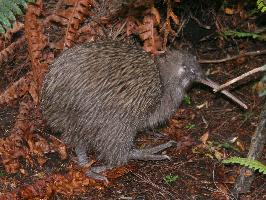
Greutăți și măsuri
| Înălțime la greabăn | 45 cm |
|---|
Starea de conservare
| Amenințat |
Descrierea animalului
The North Island Brown Kiwi, scientifically known as Apteryx mantelli, is a fascinating and distinctive bird native to New Zealand, particularly the North Island as its name suggests. This species is one of the most emblematic representations of New Zealand's unique biodiversity, belonging to the ratite family, which also includes the ostrich and the emu. However, unlike its larger cousins, the North Island Brown Kiwi is relatively small, though it is still one of the larger species of kiwi.One of the most striking features of the North Island Brown Kiwi is its appearance. It has a long, slender beak which is about one-third the length of its body, and is remarkably sensitive at the tip, allowing the bird to detect its prey underground. Its nostrils are located at the tip of the beak, an unusual trait among birds, which gives it an exceptional sense of smell. The bird's body is covered in shaggy, hair-like feathers that range in color from light brown to dark brown, providing excellent camouflage in the forest floor's underbrush.
The North Island Brown Kiwi is a nocturnal creature, emerging from its burrow only at night to forage for food. Its diet mainly consists of invertebrates, including earthworms, beetles, and other small insects. Occasionally, it may also consume small fruits and seeds. The kiwi's foraging method is unique; it uses its highly developed sense of smell to locate prey, then probes the soil with its beak to extract it.
Kiwi birds, including the North Island Brown Kiwi, are known for their remarkable reproductive system. The female lays one of the largest eggs in relation to body size of any bird in the world. The egg can weigh up to 20% of the female's body weight. After the egg is laid, the male takes on the responsibility of incubation, which lasts for approximately 75-85 days. This long incubation period is necessary for the chick to develop fully, as it emerges from the egg fully feathered and capable of fending for itself, though it often stays in the vicinity of the nest for several weeks.
Conservation status is a significant concern for the North Island Brown Kiwi. Threatened by habitat loss, predation by introduced species such as dogs, cats, and stoats, and other human-induced factors, their numbers have declined dramatically over the past centuries. Conservation efforts are in place to protect these unique birds, including predator control, habitat restoration, and the operation of kiwi sanctuaries.
The North Island Brown Kiwi plays a vital role in the cultural heritage of New Zealand, particularly among the Maori, for whom the kiwi is a taonga (treasure). Its image is widely recognized and cherished, not only as a symbol of the unique wildlife of New Zealand but also as an emblem of the nation itself, appearing on various symbols and emblems.
In summary, the North Island Brown Kiwi is an extraordinary bird that captivates the imagination with its unique features and behaviors. Its significance to New Zealand's natural and cultural heritage makes it an invaluable part of the country's identity, underscoring the importance of its conservation for future generations to appreciate and marvel at.
Fotografii noi cu animale
Top 10 animale
- Dolphin gull (Leucophaeus scoresbii)
- Diana monkey (Cercopithecus diana)
- Moustached guenon (Cercopithecus cephus)
- Stone loach (Barbatula barbatula)
- Greek tortoise (Testudo graeca)
- Galápagos tortoise (Geochelone nigra complex)
- Japanese macaque (Macaca fuscata)
- Russian tortoise (Testudo horsfieldii)
- Common flying dragon (Draco volans)
- Galápagos penguin (Spheniscus mendiculus)